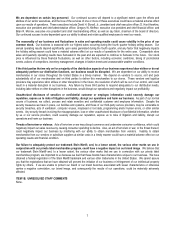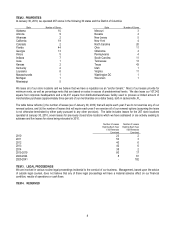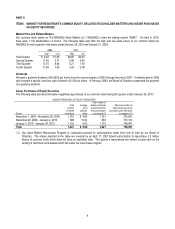Stein Mart 2009 Annual Report Download - page 19
Download and view the complete annual report
Please find page 19 of the 2009 Stein Mart annual report below. You can navigate through the pages in the report by either clicking on the pages listed below, or by using the keyword search tool below to find specific information within the annual report.compensation, deferred rent liability, postretirement benefit liability and other long-term liabilities that do not have specific due dates,
so are excluded from the preceding table. Other long-term liabilities also include long-term store closing reserves, a component of
which is future minimum payments under non-cancelable leases for closed stores. These future minimum lease payments total $6.8
million and are included in the above table.
Off-Balance Sheet Arrangements
We have outstanding standby letters of credit totaling $13.7 million securing certain insurance programs at January 30, 2010. If
certain conditions were to occur under these arrangements, we would be required to satisfy the obligations in cash. Due to the nature
of these arrangements and based on historical experience, we do not expect to make any payments; therefore, the letters of credit are
excluded from the preceding table. There are no other off-balance sheet arrangements that could affect our financial condition.
Seasonality
Our business is seasonal in nature with a higher percentage of our sales during the fourth quarter holiday selling season.
Accordingly, SG&A expenses are typically higher as a percent of net sales during the first three quarters of each year.
Critical Accounting Policies and Estimates
The preparation of our consolidated financial statements requires management to make estimates and assumptions that affect the
reported amounts of assets, liabilities, expenses and related disclosure of contingent assets and liabilities. Management bases its
estimates and judgments on historical experience and other relevant factors, the results of which form the basis for making judgments
about the carrying values of assets and liabilities that are not readily apparent from other sources. While we believe that the historical
experience and other factors considered provide a meaningful basis for the accounting policies applied in the preparation of the
financial statements, we cannot guarantee that our estimates and assumptions will be accurate, which could require adjustments of
these estimates in future periods. Following is a summary of the more significant accounting policies:
Retail Inventory Method and Inventory Valuation. Merchandise inventories are valued at the lower of average cost or market, on a
first-in first-out basis, using the retail inventory method (RIM). RIM is an averaging method that is widely used in the retail industry.
The use of RIM results in inventories being valued at the lower of cost or market as markdowns are taken as a reduction of the retail
values of inventories.
Based on a review of historical markdowns, current business trends and seasonal inventory categories, additional inventory reserves
may be recorded to reflect estimated markdowns which may be required to liquidate certain inventories and reduce inventories to the
lower of cost or market. Management believes its inventory valuation methods approximate the net realizable value of clearance
inventory and result in valuing inventory at the lower of cost or market.
We perform physical inventory counts at all stores annually. Included in the carrying value of merchandise inventories is a reserve for
shrinkage. Shrinkage is estimated based on historical physical inventory results as a percentage of sales for the year. The difference
between actual and estimated amounts in any year may cause fluctuations in quarterly results, but is not a factor in full year results.
Vendor Allowances. We receive allowances from some of our vendors primarily related to markdown reimbursement,
damaged/defective merchandise and vendor compliance issues. Vendor allowances are recorded when earned. Allowances
received from vendors related to profitability of inventory recently sold are reflected as reductions to cost of merchandise sold in the
later of the period that the merchandise markdown is incurred or the allowance is negotiated. Allowances received from vendors
related to damaged/defective inventory are reflected as reductions to the cost of merchandise as it is received. Allowances received
due to compliance issues (primarily violations of shipping and merchandise preparation requirements) are reflected as a reduction of
the cost of the merchandise when compliance issues are identified during the receiving process. Although it is unlikely that there will
be a significant reduction in historical levels of vendor support, if a reduction were to occur, we could experience higher cost of
merchandise sold.
Impairment of Long-Lived Assets. Long-lived assets are reviewed for impairment whenever events or changes in circumstances
indicate that the carrying amount of an asset may not be recoverable. Factors used in the review include management’s plans for
future operations, recent operating results and projected cash flows. For long-lived assets held for use, an impairment loss is
recognized if the sum of the future undiscounted cash flows from the use of the assets is less than the carrying value of the assets.
The amount of the impairment charge is the excess of the carrying value of the asset over its fair value. Fair value is based on
estimated market values for similar assets. Impairment reviews are performed for individual stores during the fourth quarter, or more
frequently should circumstances change. A significant change in cash flows or estimated market values could result in an increase in
asset impairment charges. During 2009, we recorded $8.4 million in pre-tax asset impairment charges related to stores closed in
2009, stores closing in 2010 and certain other under-performing stores.
17
























